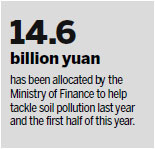Soil monitoring network passes milestone
Most grain-growing areas now covered by devices that can detect heavy metals
China has reached the halfway point in setting up a national soil monitoring network, with about 20,000 quality control devices that now cover 99 percent of all counties, according to a senior environment official.
The goal is to have 40,000 devices nationwide by 2020, "but already 88 percent of the main grain-growing areas are covered by the initial network", Qiu Qiwen, head of soil quality management at the Ministry of Environmental Protection, said on Wednesday.
The devices run regular tests using 12 key indicators - mainly heavy metals - and relay the data back to a central database. Eventually, the information will be available online to the public, as laid out in a five-year environmental protection plan released by the State Council in November.
The network is seen as a major tool to aid China's efforts to prevent and control soil pollution, as the country looks to protect its arable land and shore up its food security.

The announcement on Wednesday came as top legislators prepared to discuss a draft law governing soil pollution at their bimonthly session, from Thursday to Tuesday, which is expected to provide legal tools to push control efforts forward.
China has also launched a comprehensive study that includes a survey of farmland - including the distribution of polluted farmland and its influence on grain - which will be finished next year, as well as a survey of land surrounding polluting companies that emit pollutants including chemicals and nonferrous metals. That survey is to be finished by 2020.
"All preparation work has been completed, with unified technical standards, surveying standards and information release processes mapped out for the 31 provincial regions that will conduct the survey," Qiu said.
Soil pollution has drawn increasing attention as a result of cases exposed in recent years involving grain that was polluted by heavy metals in the soil.
The public cannot currently access timely monitoring data on soil quality, unlike the easy access to air quality information, pointing to the urgent need for the monitoring network and a thorough survey.
zhengjinran@chinadaily.com.cn
The latest data on soil pollution was released in 2014, based on a survey jointly conducted by the Environmental Protection and Land and Resources ministries, which found that 16 percent of the surveyed spots randomly selected within an area of 6.3 million square kilometers were polluted.
For example, 5,846 spots around 690 polluting companies were tested, and 36.3 percent were found to be polluted.
The two ministries are joined by the Ministry of Agriculture for the current survey, and more detailed data will emerge, Qiu said.
In response to the public's loud voice calling for controls on soil pollution, China has taken comprehensive targeted measures.
The Ministry of Finance allocated 14.6 billion yuan ($2.14 billion) to support governments in tackling soil pollution last year and the first six months of this year, Qiu said.
In fact, China has managed to reduce heavy metals emissions through strict controls. Emissions of five major heavy metals - lead, mercury, cadmium, chromium and arsenic - fell measurably from 2007 to 2015, according to data from the Environmental Protection ministry.
















